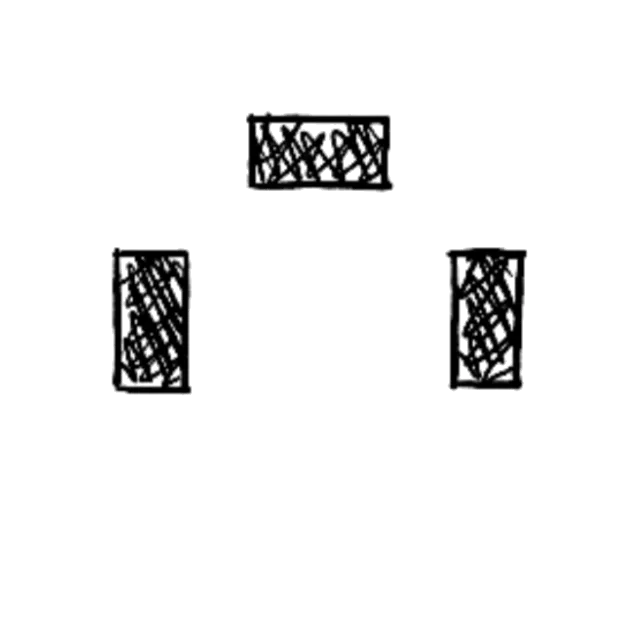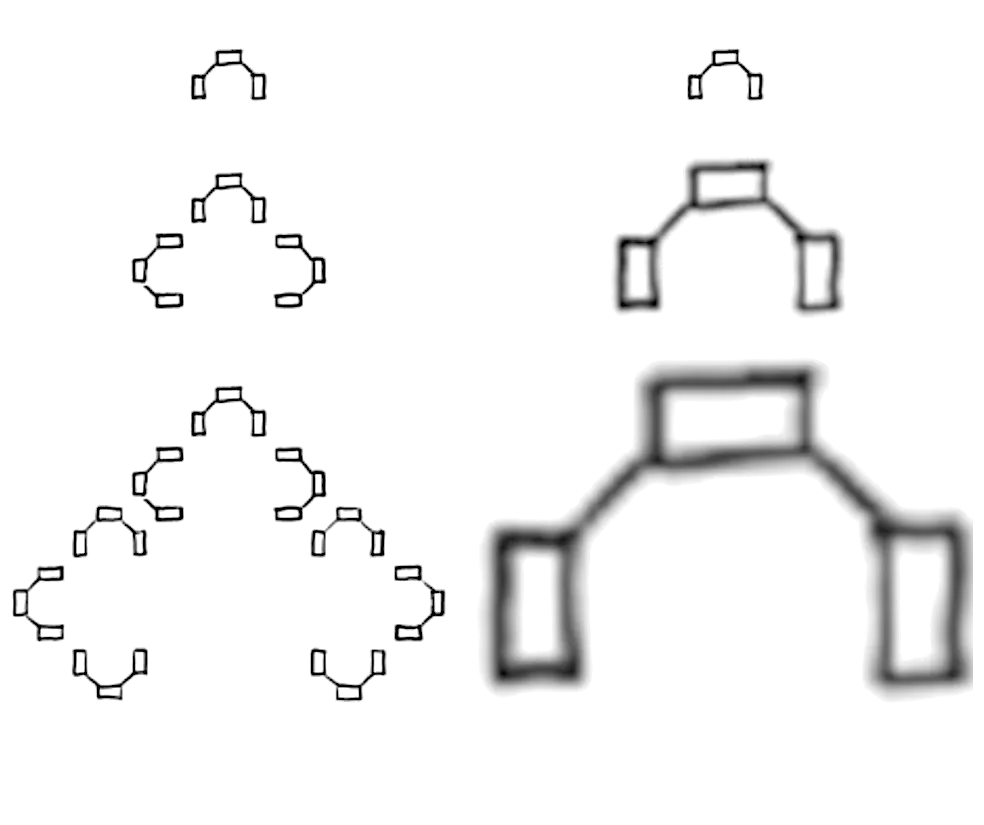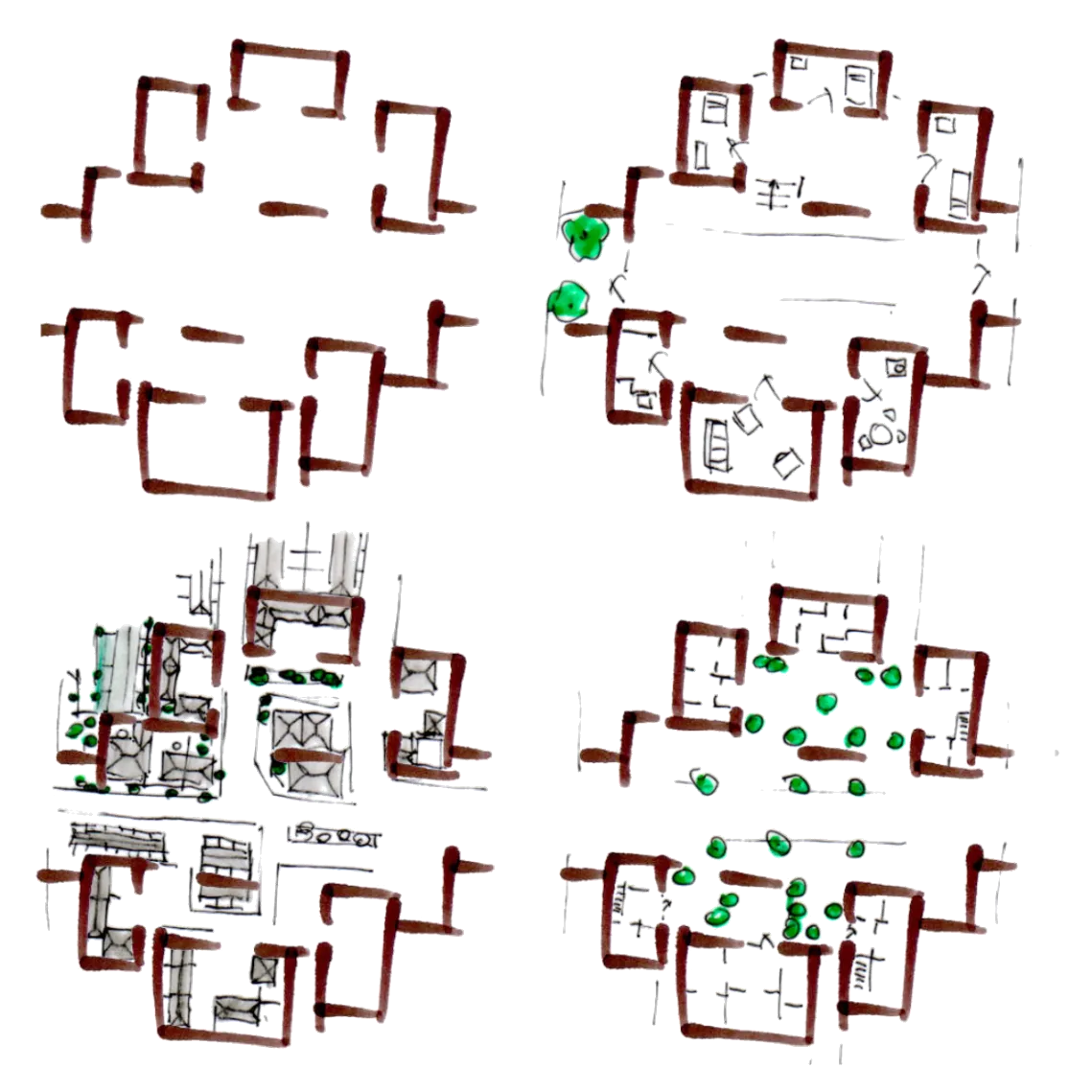The pattern of place.
In abstract,
each place a place of places at each place might be an ideal’s end by means of design some kind of exponential place
and it being sixty odd years since Aldo van Eyck wrote a definitive and self-contained instruction for the creation of ‘liveable’ urban environment, to wit:
“...make a configuration of places at each
stage of multiplication…”1,
and the design of liveable environment seeming reasonable aim for an architect, if not even the least one might expect,
and though reductive it may well seem to suggest that the full design of environment could be in ten words, yet often can the most complex of things be reduced to the most simple of equations, or proceed from them as Mandelbrot’s complexities so proceed,
and at these sixty or so years’ remove it being as relevant and true as it ever was,
then do we now elaborate on the above formula in such light, elaborating concretisation of it, with the above abstracted end in mind.
~ < · > ~
Definitional questions, directional in scope, are useful as frame.
Is there a way to design and apply basic and elemental patterns for and to development that would produce ‘good’ places at each stage of multiplication, how could that be done within contemporary practices and regulatory standards, and by what qualitative measures could one define these places as good?
Van Eyck himself said make ‘the right kind’ of places, elsewhere spoke of ‘right size’. What might be the right kind of place, what might be the right size?
How might one define ‘place’ and extrapolate the essential features of it so as to make it repeatable, and so applicable at each configurative stage?
In the context of van Eyck’s ‘configuration of places’, how might one configure, concretise or formalise place at the various scales, these configurative stages of multiplication?
Can ‘good’ place be created by similar relationships happening at different scales, so be governed by, so actually itself be, the recursive quality the formula seems to demand, wherein pattern begets pattern, and place begets place?
Is place thus in fact the very point of recursion, the junction thereof?
~ < · > ~

The above and interpretation of it once suggested something of a sketch thus, representative of an attempt to formalise a conception of place in plan, to distill its essence in architectural form, the place described in this case by three equals each come equally to it, defined and discrete but open to and part of a beyond, offering some prospect to and refuge from.
Van Eyck offered elsewhere one definition of place as ‘space in the image of man’, in which conception place becomes some portion of space imbued with a shared social meaning and value.
And place is of course not just a vibe and you'll know it when you feel it. Place and placemaking, long in the lexicon, have long too been matters of bureaucratic perfunction in development practice, paper promise of watercoloured trees unreal green or developer's grudging gift to a vague social good, rather than as we'd contend it should instead be something within the very bones of a design, in its outcomes and ongoings, at its centre and in its essence, and something to be appraised, approached and applied with rigour, realism and method.
Place the concept has not tended to be widely understood as the self-reinforcing outgrowth of recursive processes, nor as a radically anthropometric and anthropogenic social construction counterform to a physical one proceeding directly from the scale of all selves through stages of multiplication to the scale of some greater still whole yet whole. Rather has it more commonly been seen as an imperative at an ‘urban’ scale, a fixed characteristic of spaces between, defined by and apart from buildings, and not a dynamic characteristic of those at an intra-building scale, still less at a personal one.

The space within and between and the many and the large.
Elaborating concretisation of the formula in question seems straightforward, the formula itself being straightforward, and to squeeze a couple of thousand words from praise of those above quoted ten, succinct, efficient and self-explanatory as they are even in this present state so stripped of their context, may thus seem both indulgent and redundant.
It may well be both, yet to deem it either may too be to err in category.
In poetry, and those ten words above in extraction from prose become poetic, is imaginative distillation of concept.
In this and all prose might be found the opposite of a distillation, and concept rather than so condensed instead expanded upon. In poetry is often the gift of great interpretative breadth, but somewhat a curse too when advising concrete outcomes, bringing with it as it does its greater scope for misinterpretation. Prose has at least the advantage of making both its own interpretables and misinterpretations clear.
Neither poetic nor prosaic is construction documentation for the execution of a building project under a traditional contract, the detailed and complete description of means and ends, in its own ideal an absolute forfence of misinterpretation even if its reality is often to end up in front of some lawyers for their interpretation by the hour.
In these three respective media may be very different statements of the same thing, to similar and different means and ends, and the poetry would rather need a little fleshing out before sponsors or regulators could be convinced, even though one with neither right nor resource might well be happy to take the formula above and stick a shovel in the ground tomorrow.
Elaborating concretisation of the formula in question does though seem straightforward, yet will be much easier done than said, and therein indeed is the essential nature of a design process, elaborating the done in advance of the doing.
~ < · > ~
Pattern and configuration are semi-synonymous, configuration the formalisation of a relationship and pattern that of a repeatable one. The purpose being to make a configuration at each stage of multiplication, and with our foundational assumption that place itself is something that can be formalised, the above instruction could then be reformulated as ‘make a pattern of places at each stage of multiplication’.
The intent and effect here is semantic and no less for it, and further to it might one reword the above as making the pattern of place at each stage of multiplication. We’d consider then as broached above that the pattern is itself the place, the patterns themselves the places, all forms to counterforms and awaiting charge or activation through inhabitation, so charged space become place.
The same pattern for the purpose must exist at the different scales, or stages of multiplication. To allow for its design and implementation using the simple tools of our simple selves, and despite, or perhaps because of, the complexity baked into the system by the nature of its regulation and that complexity a feature of the system owing to the necessarily many relationships between its many components, it must be a simple one, and may it be too a regular one ideally orthogonal.
Designing complex systems well seems in imaginative deployment of simple means.
~ < · > ~
Central to any definition of place is of course definition. This is not tautology but recognition that central to place is that it be defined, demarcated somehow. It is not endless, place, in either reality or ideal, in the common understanding or the current or future one. It is instead radically anthropometric and radically relative - to the measure of man and from the shifting centre of him - and is it too individual, shared and dynamic, a characteristic temporarily fixed and permanently fluid.

The ‘at each stage of multiplication’ above concerns the points at which number multiplies, getting smaller or larger.
It should be underlined though explicit that these are stages, or points, or steps. The things in question, whose number it is that is multiplying, are all the things ordered by built-environmental form. For our purpose it's most useful to say that these numbers are people though in reality it be them along with all in their orbit, their wake and their way, the attendant vegetal, mineral.
The means to the organisation of this particular number is not achievable by simple single linear relationships and the multiplication of number not describable so. It is instead in each by step, stage and increment. Were we, society or humanity, to be a simple collection of individuals, each and all unrelated to any other, it could not even then be so, simple and linear, all housed within one single shed with nought in common and nowhere to go.
We are instead always and happily so in social groupings larger smaller, by turns in time dividing, combining and recombining, with and from those that we've sought or we're stuck with.
The stages of multiplication are where territorial claims, allocations or combinations change from those of smaller or larger groups in any direction, where the smaller is a part of the larger, at which the claims of the individual become shared with and equal to those of the individuals forming the household, or those of the household with and to those of all households sharing the same building storey and so forth.
~ < · > ~
Then an odd little poem here might intrude as interlude,
or indeed may it be some sutra of a sort,
‘THE UTOPIA OF EXPONENTIAL PLACE’
(and it a state and a title):
Three walls and a room, three rooms and a hall, three halls and a house.
Three houses and a green, three greens and a park, three parks and a village.
Three villages and a town, three towns and a city, three these and a that and three those and a this.
And notwithstanding that it can often be as many as four walls that make a room,
that greens, halls and parks may well be so variously defined and understood that they're of limited use for an equation of any exactitude,
yet it nevertheless is useful to propose (is ultimately central to the overall premise) that the socio-spatial structure of environment could be so defined by similar simple patterns of relationships nested within and around each other, recursive and mutually reinforcing.
The pattern could of course be other than above, another number or a more or less sophisticated basic relationship, yet for both an illustrative purpose and actual implementation would we find great use in the dynamic equilibrium of three.
~ < · > ~
Now will we return again to the pre-interlude, to territorial claims, each party in the formulation with a theoretically equal claim to the space in question, the place in the larger question, while also part of the larger group which in turn has its own territorial claim at the further stage of multiplication.
This ‘territorial claim’, while being in language suggesting a standing legally underwritten, and sometimes actually so, is in the ideal here rather a site of some social negotiation, of neighbourly give and take, its possession subject to the ebb and flow of periodic occupation, to the resultant residue of that occupation, and to the prosecution, assumption and performance of rights and responsibilities of maintenance and use associated with that occupation.
The stages of multiplication we can consider equivalent to the anthropometric scales that order for us the built environment, the personal, the household, the district and so forth, scales deriving fundamentally from the personal and proceeding outwards.
In this conception a characteristic of good urban design, design aimed at a liveable urban environment, or better yet ‘an urban environment where we all people, and with us the rest of our animal family, feel we belong, feel represented, are happy, healthy, engaged, and comfortable’, is a reconciliation of smaller groups with larger ones and ultimately with the whole.

A single pattern as structure to space at three different scales, that of a single household, that of a group of six houses, that of a district of some few dozen buildings, and the infinite scale of some pixels on a page.
Among the problems here is how to apply such a configurative approach to building design within the procurement processes that pertain today, with the regulatory, technical, financial and social constraints that inform and limit them.
Elaborating concretisation of the formula in question seems straightforward, yet nothing can be all that straightforward in such a regulatory framework as that within which contemporary development takes place, one wherein any opportunistic action on the part of an occupant is discouraged by the ever more suffocating triplet banalities of technocracy, capitalism, and ever-creeping regulatory bureaucracy.
Pattern should of course be amenable to application at the scale of the urban block in combination with that same recursive pattern beginning and ending with the individual. The chamfered corners of Cerda’s Barcelona and his urban field 'where all functions are indissolubly linked’2 are not mutually exclusive or antagonistic, are in fact the opposite, mutually reinforcing. Limits inevitably exist to the general applicability of any pattern, within both existing and ‘new’ fields (and of course no field is ever truly new). A more purist impulse (a quasi-fascist one) might privilege the zealous application of a one single and universal pattern, but an ideal, morality and reality intercede in this, and we can't now and never could afford to burn it all down and start again, and nor would or should we ever wish to. Each pattern imposed must adjust to an existing condition. In this is not just reality and a generosity accompanant, but also great generative opportunity; the right pattern will not alone allow for such adjustment but will allow of the joy of surprise in how that adjustment manifests.
Our aim, the urban environment liveable and more, will we imagine be met if the correct relationships exist at the personal scale, and exist at each point at which the configurative stage changes. Should this relationship exist at each person, and from there to each configurative step change, then should the entire socio-spatial organisation of the environment so ordered be the sum, dynamic and stable, of self- and mutually-reinforcing patterns and processes. It would be thus through the consideration of place as operating at and proceeding from the personal scale that its true reciprocity and recursivity can be realised, its radical relativity.
In this though, this idea of environment so ordered by the body moving through space, is of course well-marked conflict. The building as a project, though ultimately temporary in that nothing lasts forever, is in intent and effect permanent, and within the general regulatory, financial and contractual environments as pertain in most jurisdictions these days must be certifiable as practically complete at some point.
Place being a matter of relative perception, structure being absolute matter, it is thus in how this broad permanent framework and the overlain radically dynamic network of individual associations interact.
Through space we move, in place we dwell, per Richard Sennett, this dwelling conditional, circumstantial, relative, contingent. At points as we move through this space do we dwell, this space with some sometime enduring architectural definition then and briefly to be given personal and social definition. So as we dwell do we too make the place, so must there then be something in the space amenable to activation as place.
Truly radical development, wherein is place at the root personal, means development manifesting as radically relative and never absolute, and as suture over rupture, as constant such suturous repair at all points and scales temporal and spatial.
All acts of development must of course at some point begin, but we perhaps may need to imagine in its design our beginning more middle of a process. Our root is of course conceptually the individual, but in our present reality is individual action in such respect curtailed. The scale of an intervention useful or relevant in respect of the foregoing must be at a scale somewhat beyond the personal, though once implemented, once abstract ideal become concrete real, then will the individual’s action be no longer curtailed but enabled.
In conclusion then, conclusion enough for the time being, probably conclusion enough for good given that it was all well enough stated some 60 odd years ago and should be amplified often:
‘make a configuration of places at each stage of multiplication, i.e. provide the right kind of places at each configurative stage, and urban environment will again become liveable’
(Aldo ibid).
~ < · > ~
1. From “The medicine of reciprocity tentatively illustrated”, Forum, 1961.
2. Francoise Choay via Katarina Borsi, Intimate Metropolis, 2008.
First published August '24
© MJ Ó Ruadháin 2025